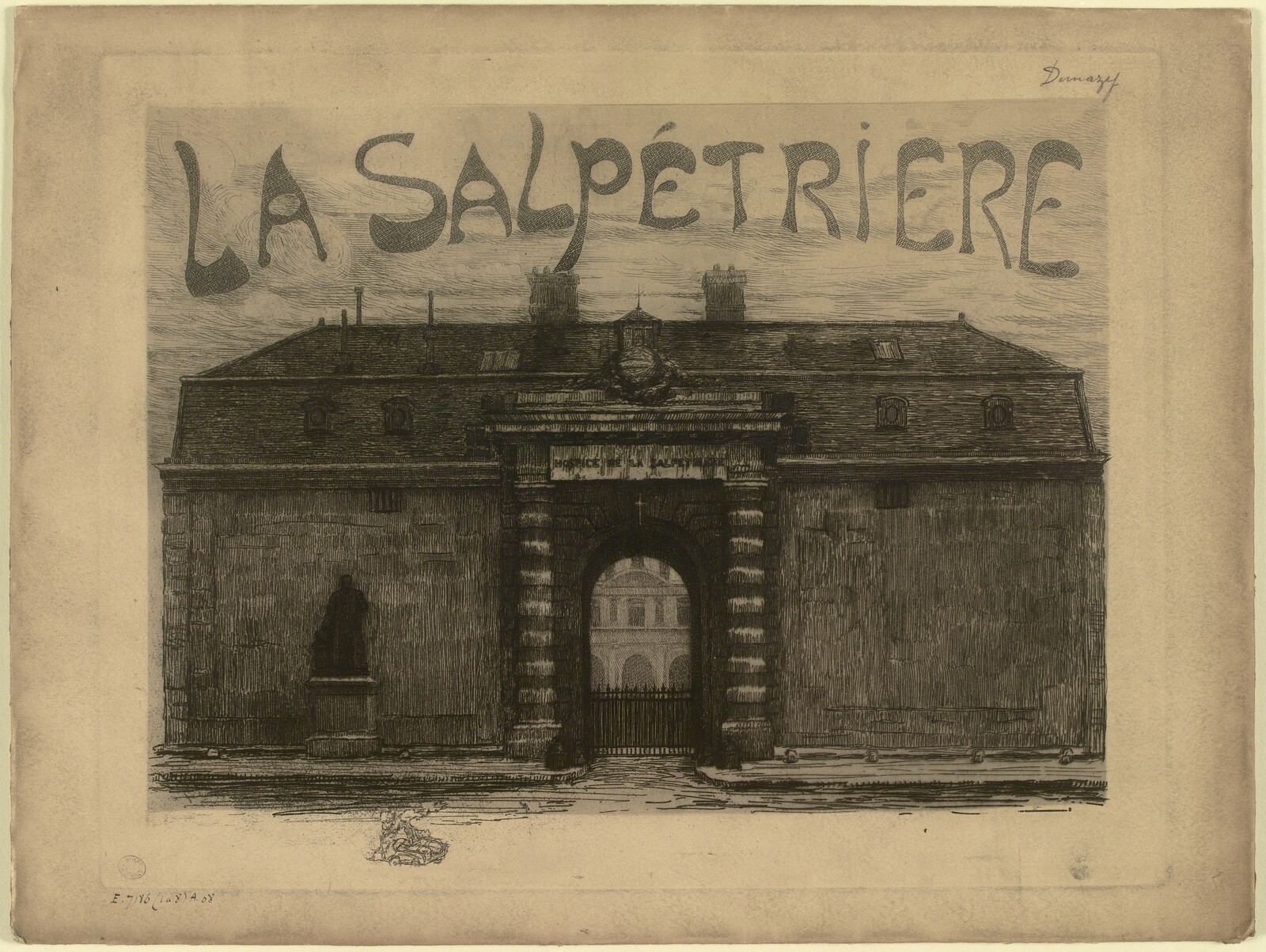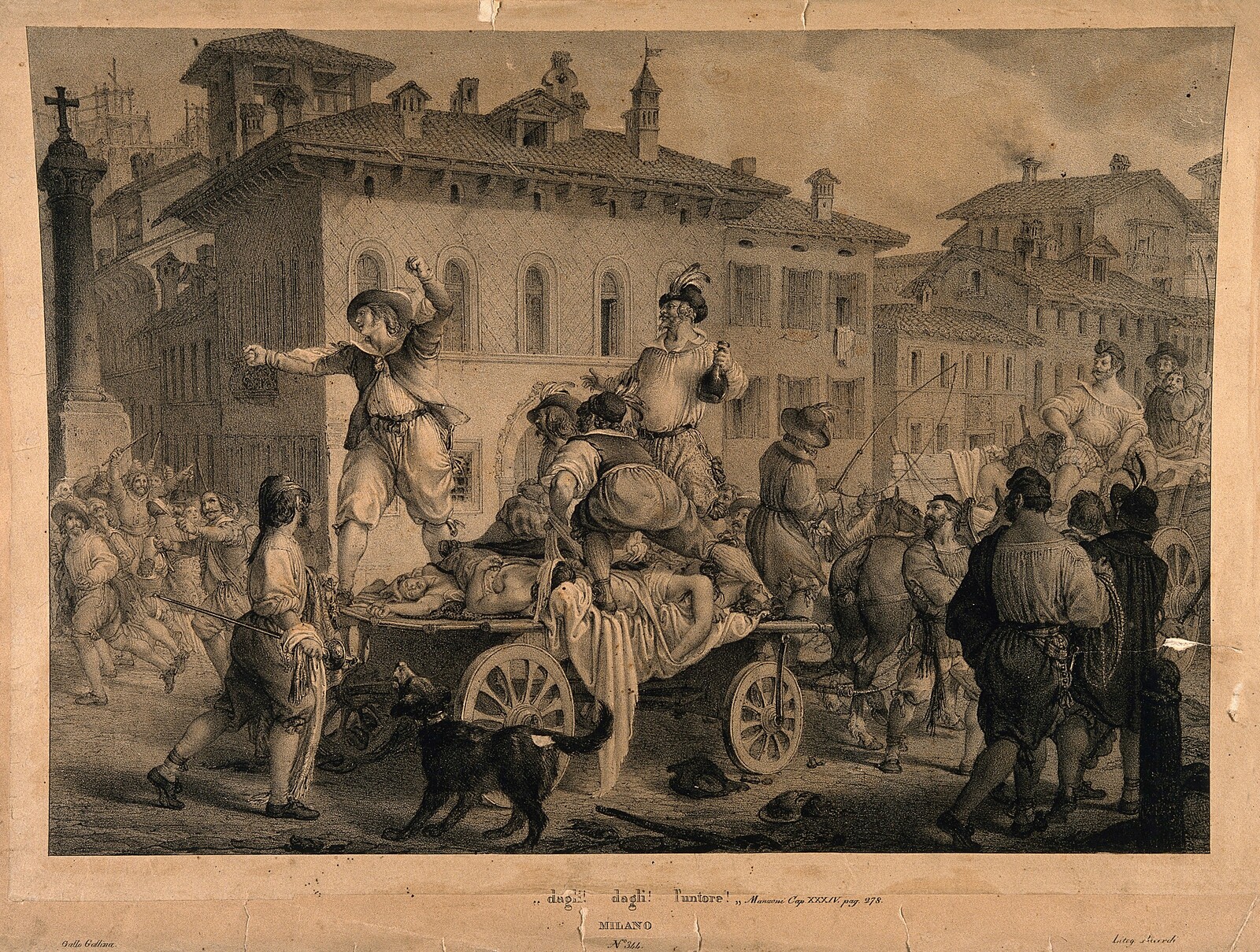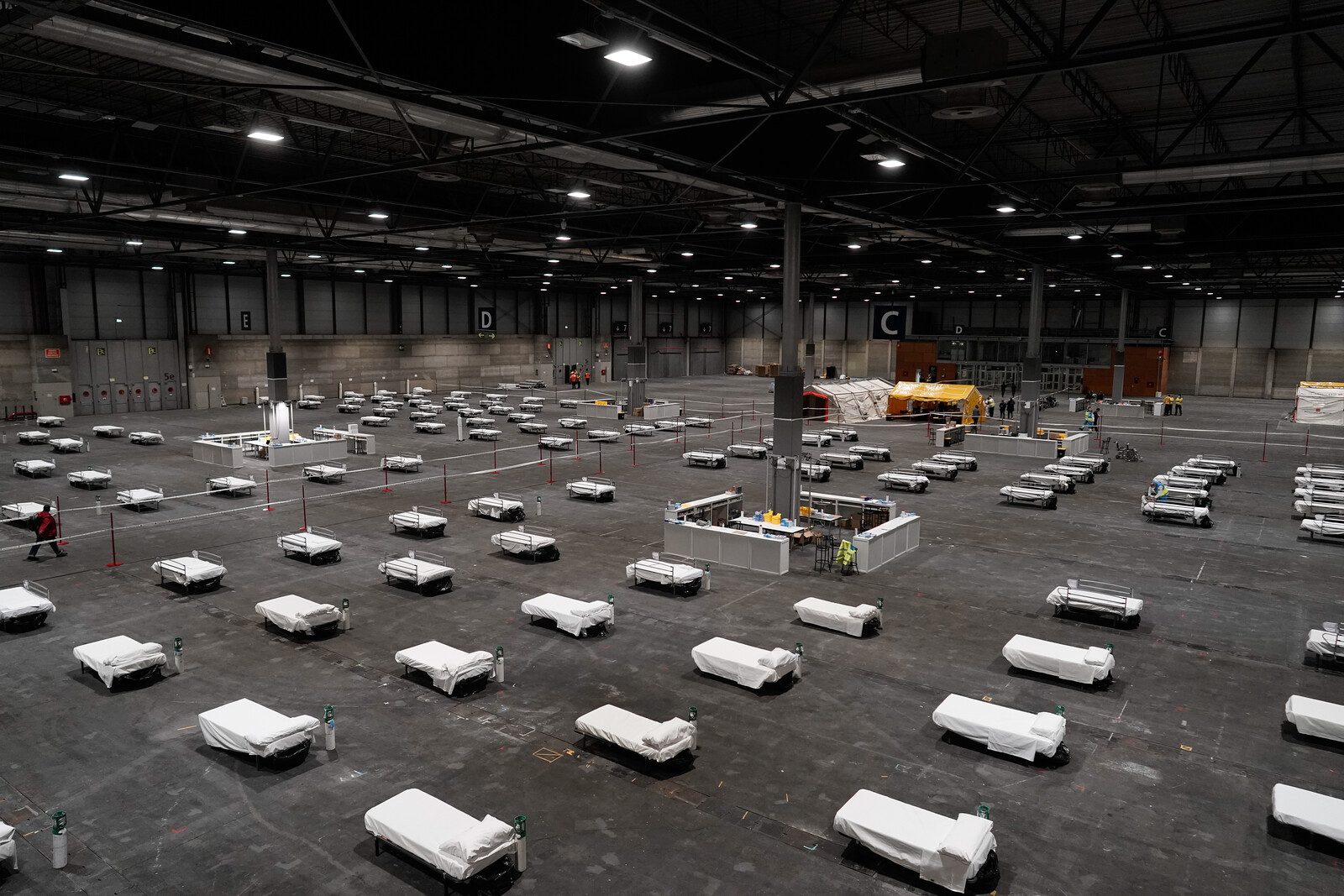March 20, 2020
I am in New York, “the epicenter of Covid-19,” the news on TV keeps blaring, as if proud of the achievement. New York has always been excessive, so why not now? More cases, more hospitalizations, more ICU admissions, more intubations, more deaths. The news is terrifying and at the same time completely at odds with the day-to-day experience of the city, which has become so strangely quiet, so peaceful. No traffic, no construction noise, no annoying car alarms, no random screams in the middle of the night. Even the ambulances are mostly silent without cars to fight against. The birds wake us up in the morning. Who knew there were so many birds downtown? There are not even parks around here and only a few trees. But maybe they came in as residents packed up their cars and left for their houses in the countryside or the beach—leaving behind a neighborhood of empty streets, just like in the 1970s when artists occupied abandoned, barely habitable lofts and there were no stores, no restaurants, and hardly anybody in the street. These same artists, at least some of them, are still around and now much more visible with all the newcomers and tourists gone. You see them in the little Korean grocery store on the corner, with their masks on, carefully selecting their vegetables, or walking slowly in the street with their dogs, or picking up take-out from restaurants. But it is the buildings themselves that have become the main actors again, the real occupants of the streets. The character of each one jumps out, etched in astonishing detail, constantly changing with the light. Could that beautiful abandoned New York return?
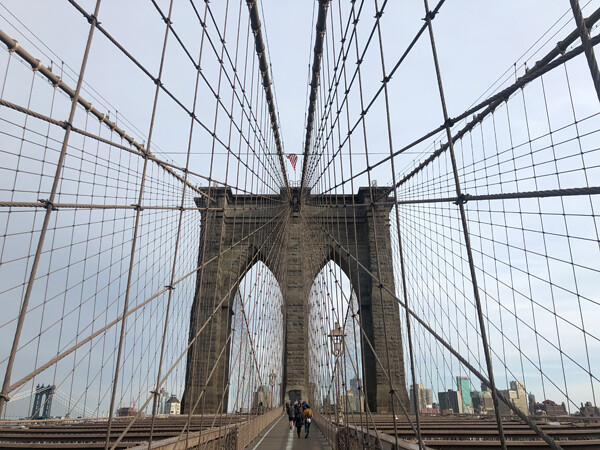

Beatriz Colomina and Andrea Marpillero-Colomina walking across the Brooklyn bridge. Photo: Mark Wigley, March 18, 2020.
March 21, 2020
Many of our friends have left the city. They think we should leave too: “It is too dangerous to stay. Besides, they may close the city soon and you will have become involuntary prisoners.” I know. But I can’t leave. I am mesmerized, glued to this place with some kind of hypnotic fascination. Andrea feels the same way. She says she is not leaving Brooklyn. We arrange to meet halfway across the bridge on a shockingly clear day. I am reminded of the blackout in New York of 2003 when she was a teenager. We were on vacation in Spain and saw it on the evening news. “Damn! We missed it,” she screamed, and everyone around burst out laughing. But I knew she meant it.
March 22, 2020
New York was still dangerous when I first arrived in 1980, but I didn’t feel that way, riding the subway in the middle of the night after partying downtown. Of course, I was robbed in the streets many times, and once someone even broke into my Columbia University apartment and held me at knife point. But all of that felt like a tax that you now-and-then randomly paid for the enormous privilege of living in a city like this. This is also how it feels right now. It is probably more dangerous to live here than in some other places, but even now, with all of us isolated in our apartments, nobody can deny you the immense feeling of being in this together, not isolated in some cabin in the woods—the solidarity with all those eyes you meet in the street, eyes above the masks. Everything is suddenly all about eyes. No smiles are possible, and yet the acknowledgment you receive from passing gazes is much more profound than the nervous smiles from before, when strangers accidentally encountered your eyes in the streets or in the subway. The metropolis smile-as-mask has been replaced by surgical masks. What would Walter Benjamin say now?


Beatriz Colomina at Washington Square Arch with an almost empty 5th avenue. Photo: Mark Wigley, March 29, 2020.
March 24, 2020
Being in New York right now is like being in the privileged position of a reporter on the front lines, as we were already on 9/11, when we were living only 200 meters away from ground zero and felt, heard, and smelled everything even before seeing anything. The engine of the second plane landed on the sidewalk just below our bedroom window. We saw things that never appeared on any screen. But now what is striking is what we don’t see. 9/11 was a media spectacle. Covid-19 is precisely not spectacular. You don’t see anything. Not even reporters, usually on the front lines of the most brutal wars and disasters, are allowed inside hospitals. There is invisible suffering everywhere. You feel it in the dense air of the streets. People are dying. But the illness, the death, is hidden. There is an architecture of this. A frightening architecture. For all the loss of barriers with contemporary media and surveillance, cameras everywhere, a huge center of our attention is completely veiled. Images of medical workers calling for equipment has become the façade of this sick architecture. They enter spaces we don’t see.
March 26, 2020
Michael Sorkin has died of complications from Covid-19. The whole architectural community is crying. I call a common friend and colleague. She says that today she had the first panic attack. The first? She must be expecting more. Without Michael it is harder to think.
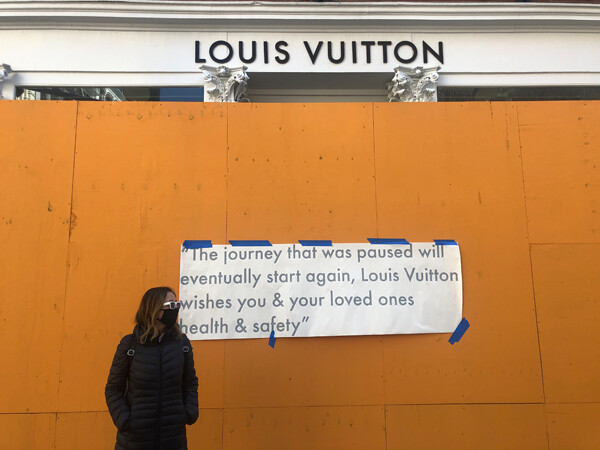

Beatriz Colomina in front of the boarded-up Louis Vuitton store in Soho, New York. Photo: Mark Wigley, March 26, 2020.
March 27, 2020
All luxury shops around here have started to board up their windows as if a hurricane was coming. Do they know something we don’t? Are they expecting civilian unrest, looting, as during the New York Blackout of 1977? Or is the city just wearing a mask like the rest of us? Think of all the doors that are closed, all the blinds that are down. The city has sealed itself—everything withdrawn behind a new façade.
March 28, 2020
Today we did the first Zoom cocktail party with what Mark affectionately refers to as the the Spanish mafia: Juan, Blanca, Muntadas, Ivan, Andres, Mark, and I. Over gin and tonics we laughed while checking in on each other. Muntadas strikes: “I am already someone else. The only thing left of my old me is the envelope, the skin.”


Greene Street at 4:32pm, what used to be rush hour. Photo: Beatriz Colomina, March 27, 2020.
March 29, 2020
Since the lockdown, we have been walking the eerily empty streets for hours every day, almost in a daze, like right after 9/11, trying to understand what has happened, what is happening to this city that we love so irrationally. All love is irrational, I suppose. “The day they wounded New York,” sounds in my head—the haunting lyric of Leonard Cohen’s song written a few years after the twin towers came down. And it rang so true, as if the city was an animate being, which it is. What would he sing now?


US Navy Hospital Ship Comfort, docked in Pier 90. Photo: Beatriz Colomina, April 1, 2020.
April 1, 2020
The Comfort hospital ship has arrived. Mark and I walked all the way up along the Hudson river to welcome it, but it was also very quiet, docked in Pier 90 around 49th street, sitting behind a veil of green net in some kind of majestic silence. Nothing to see, from there down to the Javits Convention Center, which has been turned into a hospital. The Army Corps of Engineers were moving around deep in the building’s vast interior like miniature figures, but still it was all very quiet. Some emergency vehicles idling in the streets outside, as if waiting for the unknown.
April 3, 2020
What about the regular hospitals? Could all the action be there? Today we walked for miles up 1st avenue where so many hospitals are. Again, an intense sense of silence and little to see. Just some big tents that had migrated into the street to receive patients and the ominous sight of enormous refrigerated trucks parked at the curb like any other vehicle—again waiting. Not the calm eye of the storm but the calm surrounding the storm, filling the shocked city, numbing it like an anesthetic.


Refrigerator truck acting as morgue parked in front of hospital on 1st Avenue. Photo: Mark Wigley, April 2, 2020.
April 4, 2020
Muntadas is in town. He wants a copy of my X-Ray book. We meet in the middle of an empty Greene street with surgical gloves and masks, and like two spies we exchange publications enclosed in brown envelopes. The encounter last about three minutes. I see fear in his eyes. Or is it my own fear I see reflected?


Grand Street/Broadway. Photo: Muntadas, from the series Closed/Locked, May 2020.
April 6, 2020
I thought 9/11 was the catastrophe that will define my generation. And then along came Covid-19. In many ways 9/11 was the reverse, at least for those of us who were living in ground zero and were evacuated from our apartment, living in a hotel for what seemed like an interminable time, longing to return to our homes, to our beds. Now we are confined inside and longing to be outside, in public space.


Mark Wigley in Central Park. Photo Beatriz Colomina, May 7, 2020.
April 8, 2020
The veil is gradually lifting. Nurses and doctors have become reporters, broadcasting from the battlefield inside. Images are going deeper and deeper into the hospitals, to the very beds of ICU patients surrounded and invaded by beeping equipment—the only sign of breathing, of a still beating heart.
April 10, 2020
Beds, that piece of equipment usually hidden from view, are suddenly everywhere, from the front pages of newspapers to Zoom meetings. Beds are the face of this catastrophe. First it was the urgent call for more hospital beds in the early days, then beds overflowing hospitals, filling corridors and former waiting rooms. Nobody is waiting anymore. Any room of any size has become a room for beds. The whole space of the hospital has been taken over. Then beds started to make new spaces, in tents, gymnasia, parks, ships, convention centers. Haunting images of cavernous spaces with hundreds of empty beds in a grid; each with an oxygen tank and a domestic lamp—waiting beds. The question dominating the media is always; “how many beds?”; “how many are occupied?”; how many people survived the bed? Any bed with a ventilator has become an ICU bed, so the bed becomes the room, the architecture.


Greenwich Street. Photo: Muntadas, from the series Closed/Locked, March 2020.
April 12, 2020
Beds in the street, transporting the sick, have become a common and frightening sight in the streets of New York and in the media, with medical professionals completely wrapped in protective gear, like terrestrial astronauts, complete with oxygen tanks. They are like portable rooms, some encased in a plastic bubble, reminiscent of 1960s sci-fi architecture. These portable beds act as the link between the domestic bed and the hospital bed—a vast ecology of beds, then, a whole landscape.
April 15, 2020
Beds are not just in the media as the real façade of this new city; they also are media platforms, Zooming, broadcasting, FaceTiming. Bed-to-bed communication. Think of all of those connecting with friends and colleagues from bed, all the beds you see in the background of work meetings, socializing, comedy shows, at-home music concerts, etc. No bed is a secret anymore. More than anything, I keep thinking of all of those whose last contact with their loved ones is on a tablet held by a nurse.
April 17, 2020
Now we are told to assume that we are all sick, to act as if we were sick, contagious, self-confined to our apartments, to our beds. The real epicenter of the pandemic is not New York but the bed.


Ambulance on Thompson Street. Photo: Mark Wigley, April 12, 2020.
May 1, 2020
My mother is dying in Spain. She does not have Covid. In fact, nothing is wrong with her body, except her age—ninety-seven—and with it some cognitive issues. A doctor told her a couple years ago: “You are like a vintage Mercedes car. You have your years but everything is working fine.” Covid is killing her anyway. She can’t go out with her friends anymore. She can’t even go to church, which she never cared much about, except for the social aspect of meeting her friends, going for a walk with them afterwards, for an aperitivo. “Nobody comes around here anymore,” she tells me when I call. What do you mean? Cristina, one of my sisters, picked up the phone. She is there. “Yes, well, now and then one of them comes.” In fact, they are always there but not all at once, trying to protect her and themselves. She does not understand what is happening and misses the human contact, the tumultuous family dinners, the kids, her friends. She has decided to let herself go.
May 18, 2020
Elena, my youngest sister, calls. She says our mother will not make it to the summer. “But have you explained to her what is happening?” I ask. “You are the doctor.” “We don’t want to alarm her,” she says. I think this is worse, so I try myself, over the phone:
You know, there is a terrible virus going around, something like the 1918 flu.
Really? Wouldn’t you be exaggerating? You were always such a hypochondriac, just like your father. When are you coming?
But I can’t come. Spain has closed down completely. Yet I don’t trust the airline companies that tell me nobody is flying in at all. I check online for airport activity in Valencia. An ambulance plane from Belgrade is arriving this afternoon at 7pm. That’s the extent of movement in the airport today.
August 7, 2020
Aujourd’hui maman est mort. I am happy to be here with her. She was from a generation that was born at home, in bed, and could still die, almost a century later, at home, in her bed.
The Bed in the Age of Covid-19
More than revealing something new, pandemics expose what was already there. What Covid-19 has dramatically, even shockingly, made visible is the invisible city—not just the invisible urbanism of hyper-social micro-organisms, but the invisible urbanism of inequities, hidden workers, and uneven access to care or empathy.
The new architecture of the pervasive bed is not a side effect of the pandemic but has been exposed by it. Once exposed, it might mutate again. New architectures might appear. To think about what might happen next there is an urgent need to look back and understand the intimate bonds between architecture and disease. So much of what is shocking in the current situation is what was already there but buried, overlooked or forgotten.
Already in 2012, The Wall Street Journal reported that 80% of young professionals in New York were working from bed. The bed had already become a new kind of office. The virus has taken this to a whole new level. And is there any reason to think that we will leave the bed when all of this is over, now that we have become so much better at working in bed, teaching in bed, shopping in bed, socializing with people miles away from our beds? The bed used to be the site of intimate physical contact. Now we will only get out into the street in search of such contact.
The future city may not look so different than that of today, but all its hidden rhythms will have changed. Think of working at home, in bed even, as millions have been forced to do. What was once a fantasized future is now a reality we are unlikely, or unable to give up. This turn indoors, which was already well underway in the last decade, is not a turn away from the city or from density. Far from an anti-urban force, the virus will inspire new forms of urban density, new forms of cross-contamination. The key change will not be the shape of the city but affordable housing, education, and access to healthcare. The question will not just be the relation of the bed to work but to privacy, community, equity, mobility, race, technology, energy, labor, climate, and philosophy. The bed never simply sits in a space. It both generates space and is orchestrated by massive forces. The idea of the bed as disconnection or escape—to privacy, domesticity, rest, convalescence, and dreams—was a relatively short-lived idea. It was always a fragile idea, riddled with contradictions. And now it is gone.
Sick Architecture is a collaboration between Beatriz Colomina, e-flux Architecture, CIVA Brussels, and the Princeton University Ph.D. Program in the History and Theory of Architecture, with the support of the Rapid Response David A. Gardner ’69 Magic Grant from the Humanities Council and the Program in Media and Modernity at Princeton University.




















